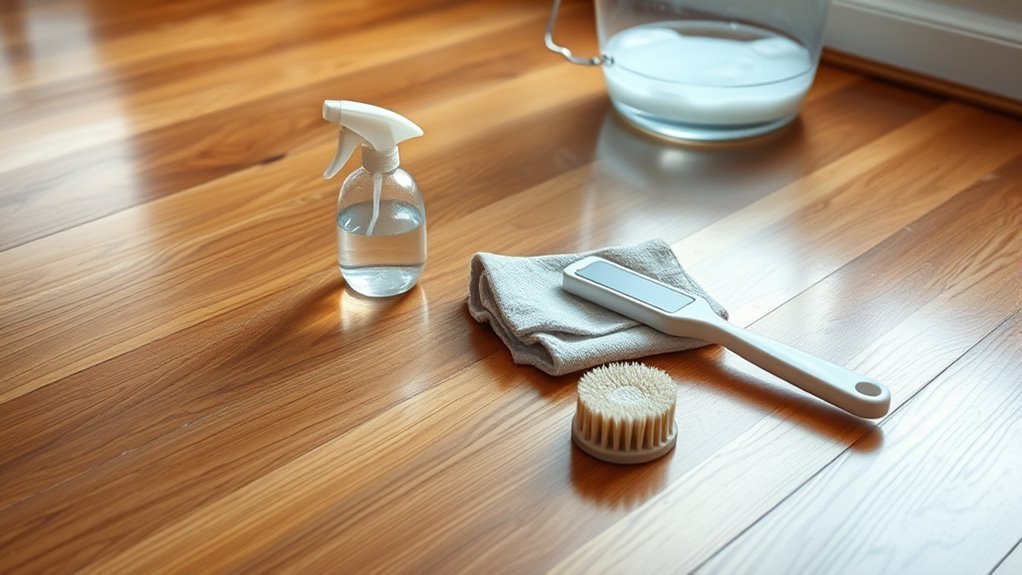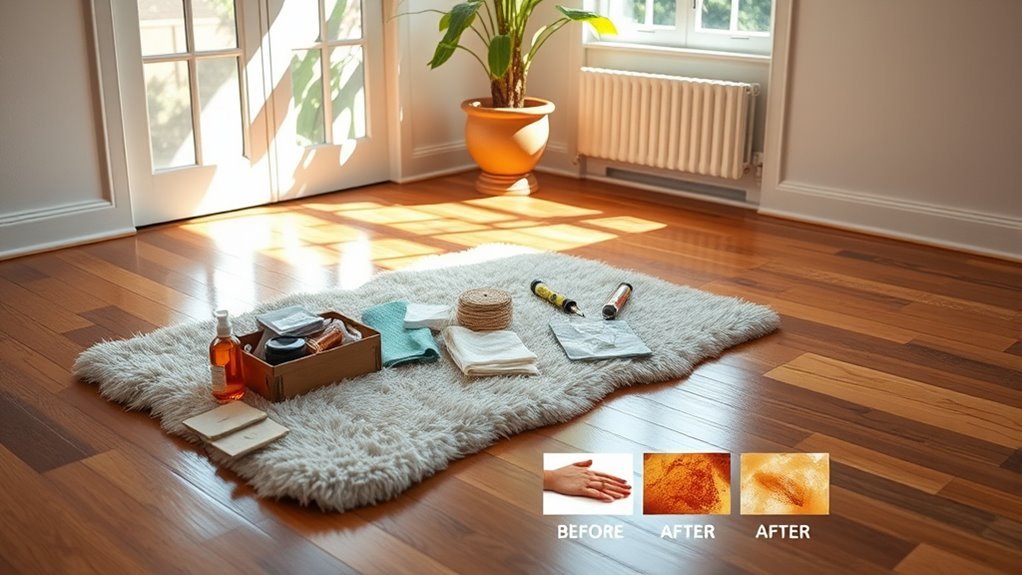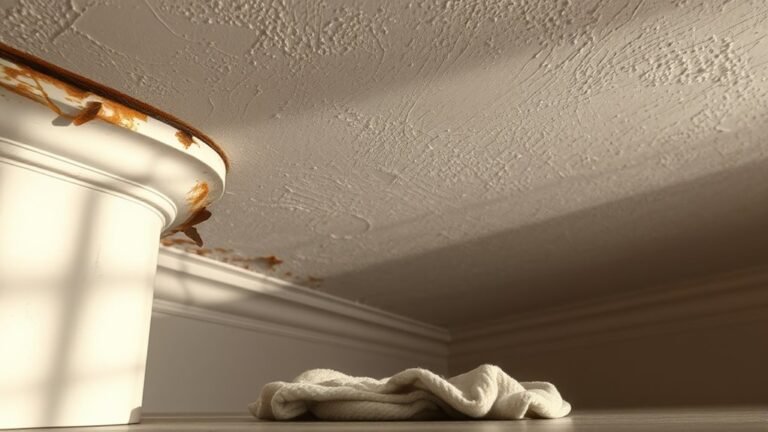Deep Cleaning Guide for Stains Flooring
To deep clean flooring stains, first identify the stain type—grease, dye, or mineral—and choose the right remover, like enzyme-based for natural fibers or solvent-based for grease. Use microfiber cloths and soft brushes to gently lift stains without damage. For hardwood, mop with pH-neutral cleaner and dry quickly; for tile, scrub grout with baking soda or diluted vinegar. Following these steps helps restore your floors, and you’ll find more tips to tackle all surface stains effectively.
Identifying Different Types of Flooring Stains

Before you can effectively tackle stains on your floors, you need to know what you’re dealing with. Stain identification methods are your first step to freedom from stubborn marks. You’ll want to observe the stain’s color, texture, and how it reacts to a gentle wipe. Remember, flooring material differences play a big role: a wood floor might absorb oils while tile resists moisture but traps dirt in grout. Carpet fibers hold onto spills differently than laminate or vinyl. By understanding these distinctions, you can pinpoint whether you’re facing a dye-based stain, grease, or mineral buildup. This insight lets you choose the right cleaning approach without wasting effort, freeing you to restore your floors with confidence and ease.
Essential Tools and Cleaning Products for Stain Removal
To tackle stains effectively, you’ll need the right tools like microfiber cloths, scrub brushes, and a spray bottle. Choosing the best stain removers for your specific flooring can make all the difference in getting results. Let’s explore which cleaning products and tools should be in your arsenal for deep stain removal.
Must-Have Cleaning Tools
Having the right tools can make stain removal much easier and more effective. When you’re ready to tackle stubborn stains, having the proper cleaning tools at hand gives you the freedom to act quickly and confidently. Here are three must-have items:
- Microfiber Cloths – Perfect for gentle scrubbing without damaging your flooring. They trap dirt and lift stains efficiently.
- Soft-Bristle Brush – Helps loosen deep-set stains without scratching. Ideal for textured or uneven surfaces.
- Spray Bottle – Allows you to apply cleaning solutions evenly, targeting stains precisely where you need them.
Equipping yourself with these cleaning tools guarantees you’re prepared for any stain removal challenge, making your deep cleaning process smoother and more effective. Keep these essentials close to maintain your freedom from stubborn flooring stains.
Effective Stain Removers
Once you’ve gathered the right tools, choosing the right stain removers makes all the difference in tackling tough spots. You want cleaning solutions that are powerful yet safe for your flooring type. For natural fibers, enzyme-based removers work wonders by breaking down organic stains without harsh chemicals. Synthetic stains like ink or grease call for solvent-based solutions to dissolve and lift them quickly. Always test a small, hidden area first to avoid damage. Remember, the best stain removal products give you freedom from stubborn marks without wasting time or effort. Keep a few versatile cleaning solutions on hand, and you’ll be ready to restore your floors with confidence and ease every time a spill happens.
Step-by-Step Deep Cleaning Process for Hardwood Floors

Although hardwood floors are durable, they need regular deep cleaning to maintain their shine and prevent damage. Sticking to a proper cleaning frequency is key for effective hardwood maintenance, giving you the freedom to enjoy beautiful floors without constant worry.
Here’s a simple step-by-step process to keep your hardwood floors in top shape:
- Clear and Dust – Remove furniture and sweep or vacuum to eliminate dust and debris.
- Mop with Care – Use a damp mop with a pH-neutral cleaner designed for hardwood; avoid soaking the floor.
- Dry and Protect – Wipe dry immediately and consider applying a wood floor polish or conditioner for extra protection.
Effective Stain Removal Techniques for Carpeted Floors
When stains appear on your carpet, it helps to know what type you’re dealing with to treat them effectively. You can often tackle common spots using simple homemade cleaning solutions that are both safe and affordable. If stains persist, professional tips can guide you on when to call in the experts for a deeper clean.
Identifying Common Carpet Stains
Because different stains require different treatments, it’s important to identify the type of stain on your carpet before you start cleaning. Spotting the stain correctly lets you tackle it smartly and saves your freedom from unnecessary scrubbing.
- Organic stains like wine stains, coffee stains, pet stains, and food stains often leave dark or colorful marks and may have a scent.
- Oil-based stains such as grease stains and paint stains feel sticky or slick to the touch and resist water.
- Mud stains and ink stains vary but usually dry hard or leave a sharp color contrast.
Knowing these differences means you’re ready to fight each stain with the right strategy, keeping your carpet and your peace intact.
Homemade Cleaning Solutions
Since store-bought cleaners can be harsh or expensive, you might find homemade solutions both effective and budget-friendly for tackling carpet stains. Using natural ingredients like vinegar, baking soda, and lemon juice, you can create effective mixtures that lift stains without harmful chemicals. For example, mix equal parts white vinegar and water in a spray bottle, then sprinkle baking soda on the stain before spraying the solution. Let it fizz and sit for 10-15 minutes, then blot with a clean cloth. This method breaks down stains and neutralizes odors, freeing you from harsh products. With these simple, natural ingredients, you gain control over your cleaning routine, ensuring both your carpet and health stay protected while saving money. Give these DIY solutions a try for a fresh, stain-free carpet.
Professional Stain Removal Tips
Although homemade solutions work well for many stains, some require professional stain removal techniques to fully restore your carpet’s appearance. Different stain types, like wine, ink, or grease, demand tailored approaches that only experts can provide. To free yourself from stubborn marks, consider these professional cleaning techniques:
- Hot Water Extraction – This deep-cleaning method loosens and removes embedded dirt and stains without damaging carpet fibers.
- Enzymatic Cleaners – Perfect for organic stains like pet accidents, they break down stain molecules for thorough removal.
- Chemical Solvents – Ideal for tough stains such as ink or paint, these agents dissolve residues that regular cleaners can’t handle.
Best Practices for Cleaning Tile and Grout Stains
When tackling tile and grout stains, it’s important to choose the right cleaning method to avoid damaging the surfaces. Start with a gentle cleaner or a mixture of baking soda and water, applying it to grout lines and stained tiles. Use a soft brush to scrub without scratching. For stubborn stains, a diluted vinegar solution can work, but avoid harsh chemicals that erode grout or tile finish. Remember, regular tile maintenance keeps surfaces looking fresh longer. After cleaning, applying grout sealing protects against future stains and moisture, preserving the grout’s integrity. By following these best practices, you maintain your freedom to enjoy beautiful floors without constant worry about damage or discoloration. Clean smart, protect well, and your tile floors will reward you with lasting appeal.
Preventative Measures to Minimize Future Floor Stains

To keep your floors looking their best, taking preventative steps is essential for minimizing future stains. Embracing preventative maintenance not only saves you time but also keeps your space feeling open and fresh. Here’s how you can guarantee effective floor protection:
- Use mats and rugs at entryways to catch dirt and moisture before they reach your floors.
- Clean spills immediately to prevent stains from setting in and becoming harder to remove.
- Apply a sealant or protective coating suited to your floor type to create a barrier against stains and wear.
Frequently Asked Questions
How Often Should I Deep Clean My Floors to Maintain Stain-Free Surfaces?
You should deep clean your floors about once a month to keep them looking fresh and stain-free. Sticking to a regular cleaning frequency helps with effective floor maintenance, preventing dirt build-up and stubborn stains. Of course, if you’ve got pets or heavy foot traffic, you might want to clean more often. This way, you’re free to enjoy your space without worrying about grime stealing your vibe.
Can Natural Cleaning Products Be as Effective as Chemical Cleaners for Tough Stains?
You might wonder if natural alternatives can match chemical cleaners in stain effectiveness. While natural products like vinegar, baking soda, and lemon juice may take a bit more elbow grease, they often deliver impressive results without harsh chemicals. If you want freedom from toxins and a greener approach, these alternatives can be just as effective for many tough stains, especially with consistent use and patience.
What Are the Environmental Impacts of Common Floor Cleaning Chemicals?
Imagine your floor cleaner as a storm wreaking havoc on the environment—chemical residues can seep into water and soil, disrupting ecosystems. You’ve got the power to break free from this cycle by choosing sustainable alternatives that respect nature’s balance. With evolving chemical regulations, safer products are emerging, giving you freedom to clean without guilt. Embrace greener choices, and watch your home shine while protecting the planet you love.
How Do I Safely Remove Pet Urine Stains From Flooring?
If you’ve got pet urine stains on your floor, start by blotting the area gently to avoid spreading the mess. Use an enzymatic cleaner designed to break down urine odor molecules—that way, you’ll tackle the source, not just the stain. To keep freedom from recurring, focus on stain prevention by cleaning accidents quickly and training your pet well. That way, your floors stay fresh, and you enjoy a carefree, clean home.
Are Professional Floor Cleaning Services Worth the Cost for Stain Removal?
Considering cost and convenience, professional floor cleaning services can be a smart solution. By doing a cost analysis, you’ll see that while upfront fees might feel steep, the service benefits—like thorough stain removal, time saved, and expert care—often outweigh the expense. If you crave freedom from scrubbing and stress, investing in pros lets you reclaim your time and enjoy spotless floors without the hassle. It’s about smart spending for lasting results.






